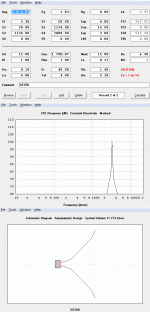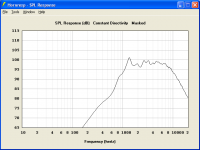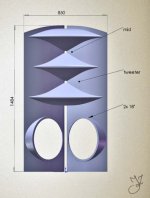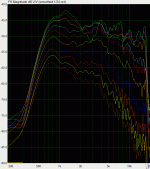These are master molds so flange will be removed. In February we will add SEOS-18 and SEOS-12. Samples are going to Scaper and ZilchLab for testing.
Cool, We need to show those pics...very nice!!! Who is Scaper?? EricH getting a sample too?
Cool, We need to show those pics...very nice!!! Who is Scaper?? EricH getting a sample too?
Ah come on Doug!!! Yeh, Scaper is Erich H!! That's me. 😀 😀
Jack said he would send me the prototypes and I'm going to get them tested. I will also be sending them to Zilch. I've been trying to contact him, but I think he's taken some time off for a while. I have others that will also do some testing. Plus the guys in Poland will be running tests as well I'm sure.
Last edited:
Bill, did you find another QSC HPR-152 (re: your post on techtalk classifieds)?
Nope, not so far. Had one lined up from Zilch, but he has been out of touch as we all know, don't want to bug him about it.
edit: correction -- your post reminded me to check in those classified and Penngray wrote to say he has some.
Last edited:
Did you happen to mix up the tags on those two?SEOS 15" waveguide and popular "classic" horn Tractrix-200. Prototypes.
I've heard that hornresp is better suited to bass horns, so don't shoot me. I was just hoping for a quick tool. Is it this bad or have I done something wrong?
The driver data was gleaned from here http://www.diyaudio.com/forums/multi-way/100392-beyond-ariel-92.html#post1638389
EDIT: if the image doesn't open fully, try a new tab. It's high enough resolution to read.
The driver data was gleaned from here http://www.diyaudio.com/forums/multi-way/100392-beyond-ariel-92.html#post1638389
EDIT: if the image doesn't open fully, try a new tab. It's high enough resolution to read.
Attachments
Last edited:
Read down a few posts where you linked. The parameters had typos. Mmd is more like 1.2g, not 15g.
Is it this bad or have I done something wrong?
Hi AllenB,
While Hornresp is not perfect, it is definitely not as bad as your result would indicate 🙂.
Using Dr Geddes' suggested alternative driver parameter values BL = 18.00, Cms = 2.00E-05 and Mmd = 1.20 the Hornresp predicted SPL response will be as shown below.
Kind regards,
David
Attachments
Thanks David, I can certainly see my oversight.
I have used Hornresp in the past to build various bass horns and it has proved invaluable.
I notice in my above example that changing the length of the second (conical) section (and whilst also keeping the angle), the response changes little. I realise that there is more to a waveguide's response than an just an on axis shot. I recall reading that waveguide mouth size has less to do with the cutoff frequency than would seem obvious. Would you consider your simulation to be within cooee of the correct response?
BTW, your wavefront animations are enlightening.
I have used Hornresp in the past to build various bass horns and it has proved invaluable.
I notice in my above example that changing the length of the second (conical) section (and whilst also keeping the angle), the response changes little. I realise that there is more to a waveguide's response than an just an on axis shot. I recall reading that waveguide mouth size has less to do with the cutoff frequency than would seem obvious. Would you consider your simulation to be within cooee of the correct response?
BTW, your wavefront animations are enlightening.
Hi AllenB,
While Hornresp is not perfect, it is definitely not as bad as your result would indicate 🙂.
Using Dr Geddes' suggested alternative driver parameter values BL = 18.00, Cms = 2.00E-05 and Mmd = 1.20 the Hornresp predicted SPL response will be as shown below.
Kind regards,
David
That's almost exactly the response characteristic I'm getting from my 15" OSWGs with JBL 2426h and CD compensation. quite a bit smoother at the bottom end though, I used a decent sized roundover.
An externally hosted image should be here but it was not working when we last tested it.
Last edited:
Would you consider your simulation to be within cooee of the correct response?
Hi AllenB,
Provided that the driver and front and rear chamber parameter values are reasonably accurate, then the SPL power response predicted by Hornresp should be reasonably close to the measured results. Note that this is not just confined to bass horns.
Kind regards,
David
Last edited:
Here's something new and interesting from B&C.
But first, a bit of background.
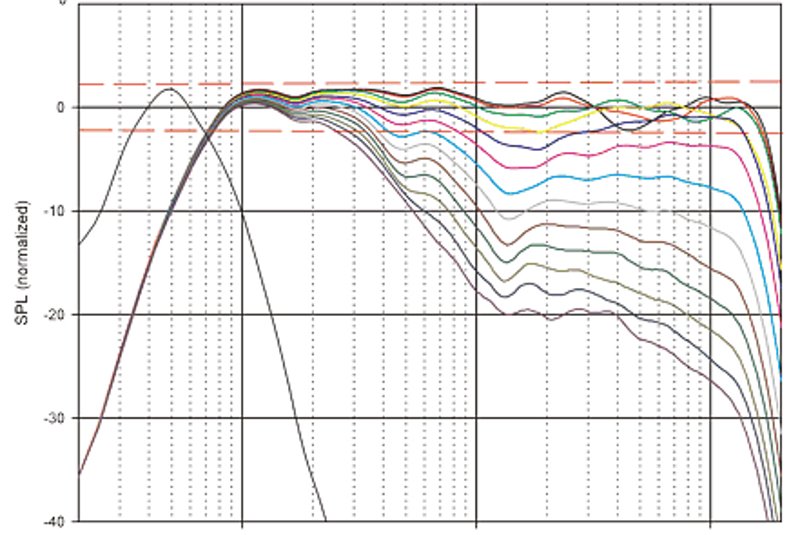
This is the polar response of my Summas. In the top octave, you see that the response falls off. This is because the compression driver has a relatively large diaphragm, much larger than a conventional dome, and it simply can't play out to 20khz. There are alternatives from TAD which can, but they are MUCH more expensive.
I happen to like a lot of the very small compression drivers, like the Celestion CDX1-1425, and the BMS 4540ND. I use them almost exclusively in my projects. The reason is simple - I am willing to trade power handling and raise the crossover point, in order to achieve that pristine clarity that you hear with a good dome or a ribbon.
One thing that's a bummer about the BMS and the Celestion is that they require a one inch throat. I've often wondered if it would be possible to improve on the high frequency polar response with a smaller throat. I even ruined a couple of compression drivers in an attempt to modify the phase plug. (It didn't work, AT ALL.)
Enter this new product from B&C:
B&C SPEAKERS
It's a compression driver with a 1/2" throat. Neat.
I'll bet you could make a heck of a loudspeaker if you combined this with an 8" woofer.
Even better, based on this price list here, it should cost about a third as much as a B&C DE250:
http://www.showtek.it/files/bcspeakers_listinoprezzi.pdf
But first, a bit of background.

This is the polar response of my Summas. In the top octave, you see that the response falls off. This is because the compression driver has a relatively large diaphragm, much larger than a conventional dome, and it simply can't play out to 20khz. There are alternatives from TAD which can, but they are MUCH more expensive.
I happen to like a lot of the very small compression drivers, like the Celestion CDX1-1425, and the BMS 4540ND. I use them almost exclusively in my projects. The reason is simple - I am willing to trade power handling and raise the crossover point, in order to achieve that pristine clarity that you hear with a good dome or a ribbon.
One thing that's a bummer about the BMS and the Celestion is that they require a one inch throat. I've often wondered if it would be possible to improve on the high frequency polar response with a smaller throat. I even ruined a couple of compression drivers in an attempt to modify the phase plug. (It didn't work, AT ALL.)
Enter this new product from B&C:
B&C SPEAKERS
An externally hosted image should be here but it was not working when we last tested it.
It's a compression driver with a 1/2" throat. Neat.
I'll bet you could make a heck of a loudspeaker if you combined this with an 8" woofer.
Even better, based on this price list here, it should cost about a third as much as a B&C DE250:
http://www.showtek.it/files/bcspeakers_listinoprezzi.pdf
Nice!
jzagaja,
Yet another beautiful design in the works! Any background/discussion on this particular build, and will it be a candidate for a group buy later? (the shipping is going to be $$$ judging from the size of it...) 😀
Cheers,
Jaz
jzagaja,
Yet another beautiful design in the works! Any background/discussion on this particular build, and will it be a candidate for a group buy later? (the shipping is going to be $$$ judging from the size of it...) 😀
Cheers,
Jaz
BMS goes up to 30kHz, BC DE5 only up to 18kHz. No real advantage? I'm on making OB prototype with 30" SEOS waveguide - DE5 can be used with midrange compression driver.
New model release takes usually 2 months - one month for mold stabilization and one month for crossover stuff and test.
....
I've often wondered if it would be possible to improve on the high frequency polar response with a smaller throat. I even ruined a couple of compression drivers in an attempt to modify the phase plug. (It didn't work, AT ALL.)
Enter this new product from B&C:
B&C SPEAKERS
An externally hosted image should be here but it was not working when we last tested it.
It's a compression driver with a 1/2" throat. Neat.
...
Thanks a lot for sharing this.
0.5 in throat is really new to me. And it seems B&C has not yet come up with a matching horn for it. (only for the slightly bigger one with 0.75in throat... )
It must be very interesting to see a wide directivity horn with this. A 120 degree radial horn with LeCleac'h contour? Oops, the the wrong thread.
Would someone with more experience than me critique my waveguide based on this plot? It shows 10 degree increments from 0 to 90. No crossover.
The baffle appears the same top, left and right, so I will therefore assume that this plot is a representative sample, and calculate a power response from it. I plan to feed that power response into my crossover simulator. Does this seem reasonable?
The baffle appears the same top, left and right, so I will therefore assume that this plot is a representative sample, and calculate a power response from it. I plan to feed that power response into my crossover simulator. Does this seem reasonable?
Attachments
- Home
- Loudspeakers
- Multi-Way
- Geddes on Waveguides
